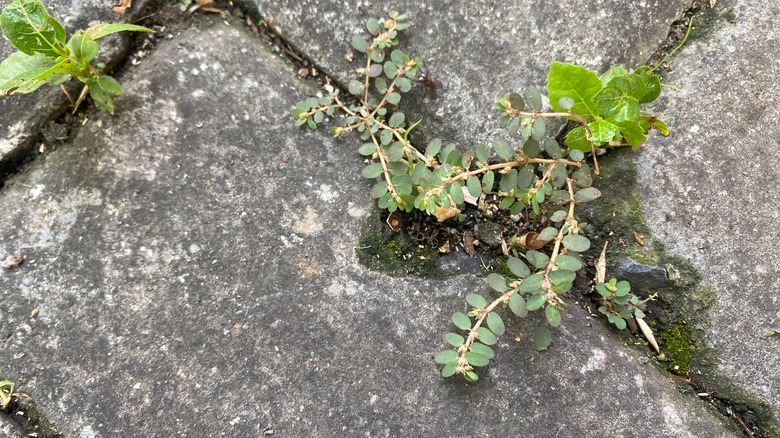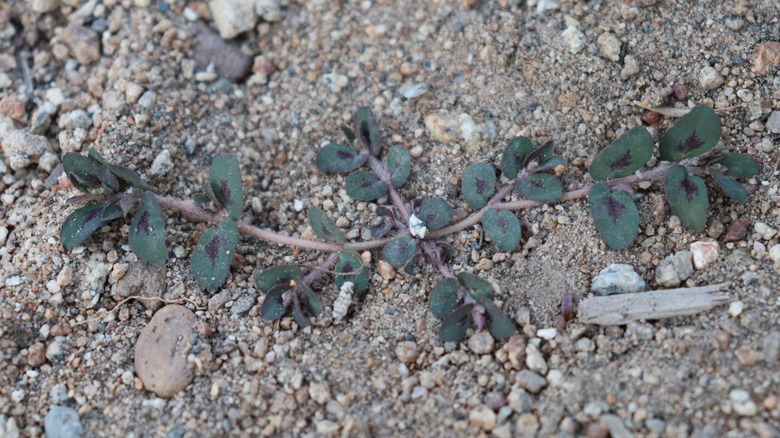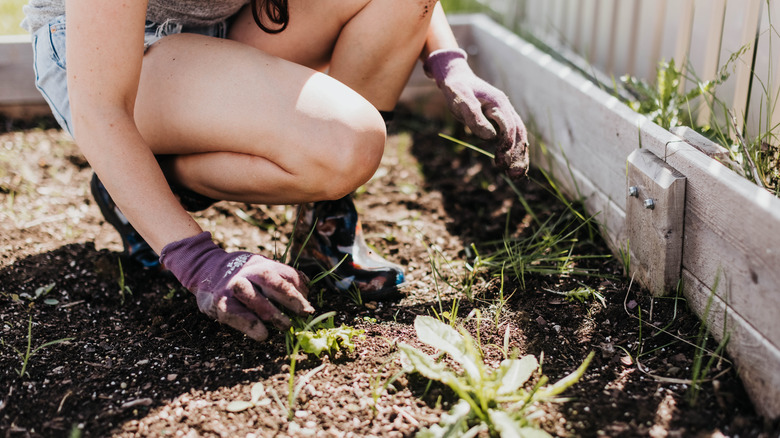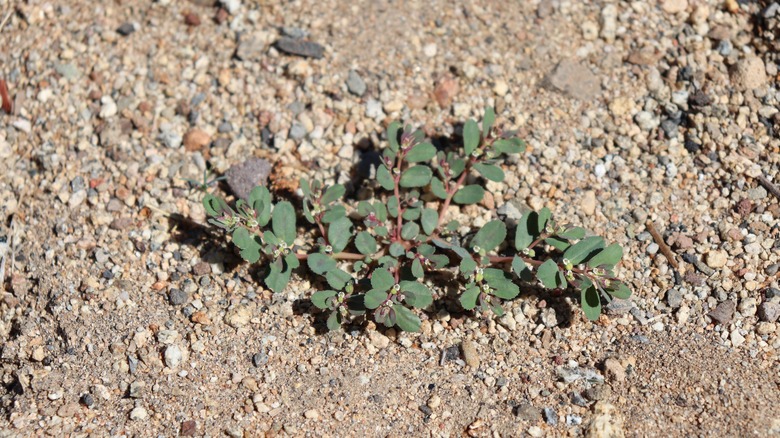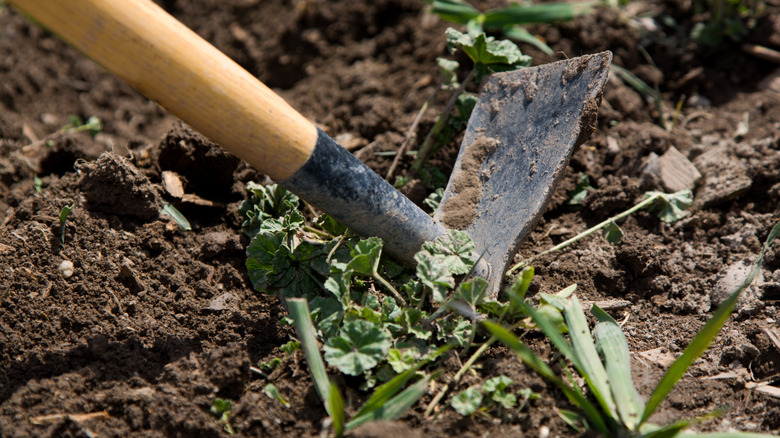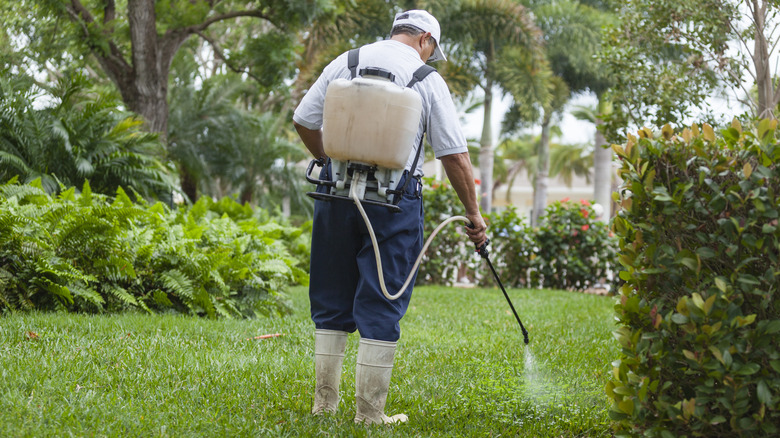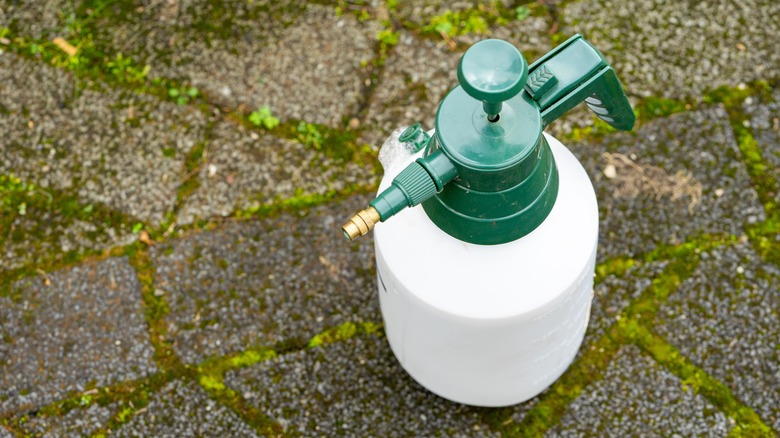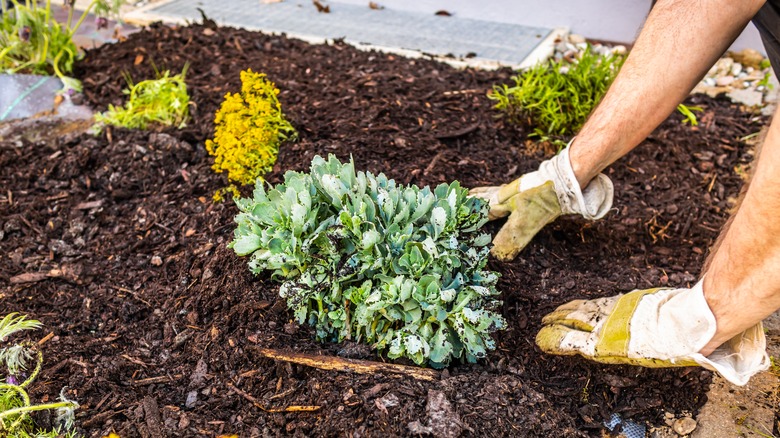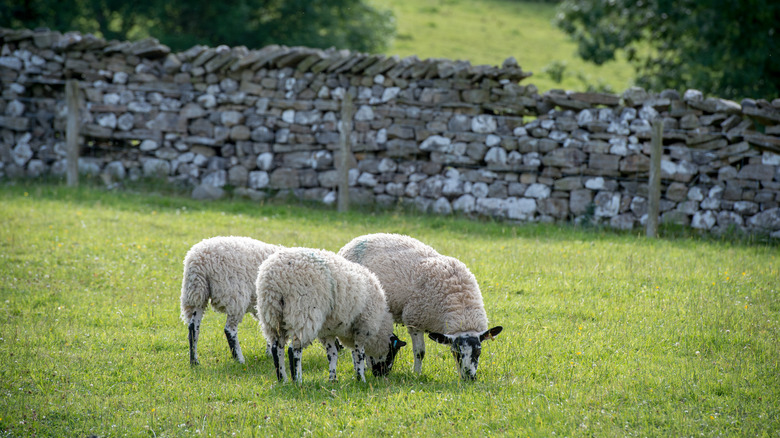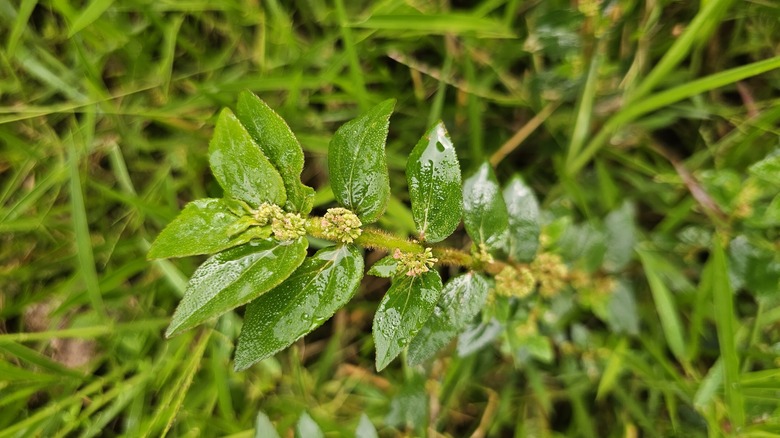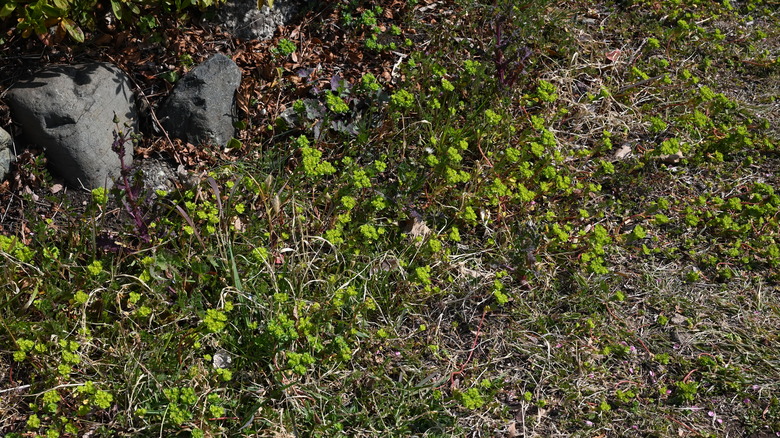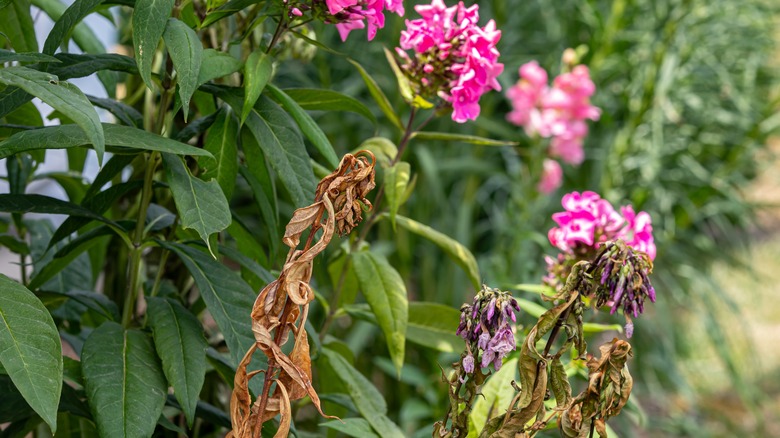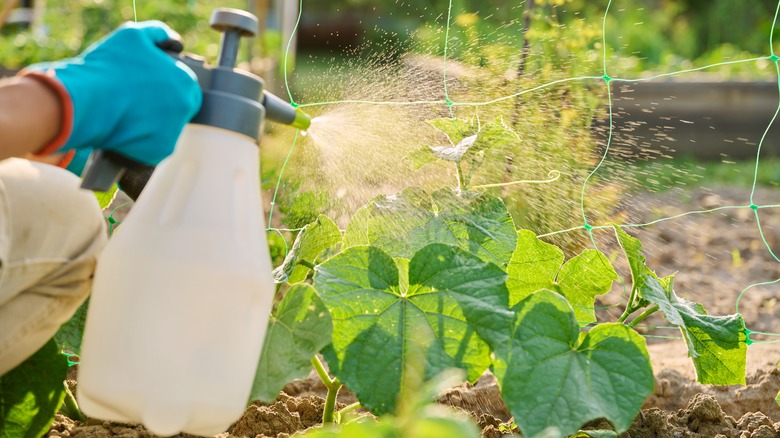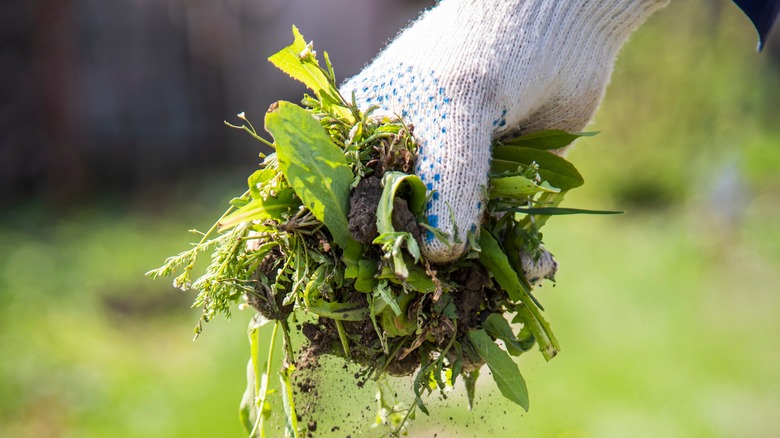Mistakes Everyone Makes When Dealing With Invasive Spurge Weed
Weeds can quickly take over your garden — or even your entire yard. However, while some weeds are relatively easy to control, others can spell serious trouble. Spurge is one of these invasive weeds that you'll want to do everything you can to avoid letting it overrun your lawn or garden. While spurge emerges during the summer, the weed remains dormant throughout the winter, just waiting to re-infest your property. There are a few different varieties of spurge weed, most of which are low-growing plants with hairy, reddish-purple stems and small dark green leaves that often have tiny spots. Spurge may flower, but these flowers are often hidden between the thicker clusters of leaves.
Knowing how to remove spurge from your yard is essential, and there are several common mistakes people make when attempting to do so. Not only can these mistakes prevent you from effectively removing the weed, but in some cases, they may make the infestation even worse. Read on to learn more about what you shouldn't do when trying to get rid of spurge and what you should do instead to keep the weed from taking over your lawn or garden.
Failing to act quickly
When you're dealing with spurge, time is of the essence. Failing to act quickly will only make the task of removal far more difficult. Spurge is easiest to remove when the plants are young and only in small patches. Once the weed spreads and takes over more of your yard, eradicating it will be a much more time-consuming and laborious process.
When you spot spurge in your yard or garden, start the removal process immediately and frequently revisit the area to remove any weeds that sprouted back up or resisted your initial attempts. When the weed is young, pulling it by hand is possible because the roots aren't as deep or well-established as those of more mature plants. Even with prompt removal, it is still essential to continue monitoring the area where you identified the spurge, particularly if the weed had started to flower. Once the weed has flowered, it means seeds have been produced. These seeds can, obviously, produce new growths. So, check back on the area regularly for at least eight years, as this is how long seeds can remain viable.
Failing to pull all the roots
Some people who see spurge growing in their yard will remove the part of the weed that's visible, and then call it a day. Unfortunately, such actions will not fully remove the spurge from your yard. If you are going to weed spurge by hand, it is essential to pull up all of the roots. If even a small fragment of the roots are left in the ground, they can generate new shoots. This will allow the weed to quickly re-invade the space.
It is important to note that hand-pulling spurge isn't generally recommended as an effective long-term solution. The only time it may work — and again, only if you're exceptionally tedious and remove the entire root system — is during the first year of growth. After spurge has been established for more than a year, it develops a very deep tap root. It is simply not feasible to fully remove this tap root by hand-pulling. At this point, herbicides are your best option.
Weeding when the soil is too dry
If you are going to try to pull up new spurge weeds by hand, it is also important to do so at the right time. If your soil is overly dry when you weed, the spurge roots are going to be dry too. This means that when you try to pull the plant out of the ground, the roots will likely break. As mentioned earlier, this can be disastrous with spurge, as new growths can regenerate from a small piece of root.
To avoid this problem, only try to hand-pull spurge if the soil is moist. The ideal time to work would be a day or two after it has rained. Just be sure to also avoid attempting to weed if the soil is overly saturated, as this can also be problematic too. Wet soil will be too clumpy for you to effectively pull the spurge — roots and all — from it.
Raking the ground to make them easier to pull
Raking the ground when trying to get rid of spurge weeds may sound like a common-sense solution. When you loosen the soil, the weeds should be easier to remove, right? Well, maybe. But, the bigger issue is the new problem you'll create by raking. When you use a rake to loosen the dirt, you're also pulling newer spurge weeds to the surface. These weeds could have been sitting dormant farther below the surface, but as soon as you pull them up to the top, they'll be primed to germinate and start infesting your yard.
To avoid this problem, skip trying to rake and loosen the soil when hand-pulling spurge. Follow the advice above to wait for the soil to be moist a few days after a rainstorm before you attempt to remove the weed. Also, remember, hand-pulling won't be an effective solution if the weed has been established for more than a year — and even if it is a very young weed, you must take extra care to pull out the entire root system. As mentioned before, herbicides are your next line of defense.
Applying pre-emergent herbicides at the wrong time
When you're looking for the best way to get rid of spurge, using pre-emergent herbicides can be an effective approach. However, many people make the mistake of applying these herbicides at the incorrect time. The name pre-emergent says it all. It means you must use it before seeds emerge from the ground. So, if you're applying pre-emergents after you've already spotted spurge growing in your yard, you're acting too late. Applying pre-emergents to sprouted spurge won't do anything to kill the weed.
Instead, pre-emergents must be applied to the yard or garden before spurge appears. If you know you had a spurge problem last year and are just waiting for it to pop back up as the weather gets warmer, you can get ahead of the game and try to stop it in its tracks with a pre-emergent herbicide. Before applying the herbicide, carefully read the directions from the manufacturer to ensure proper mixing, application, and coverage.
Trying to kill mature spurge plants with vinegar
You may have heard that vinegar is an effective weed killer that can help you clear up a spurge infestation. While this thinking isn't completely false, it also isn't 100% accurate. Using vinegar on well-established, mature spurge weeds isn't going to be the best approach, as effective eradication using vinegar is going to require too many applications.
If you're dealing with mature spurge weeds, you'll have the best luck using a post-emergent herbicide. That being said, if you want to try using vinegar to kill spurge, stick with using it on newer, annual growths. Choose a herbicidal vinegar with a higher concentration of acetic acid (around 20%). In a pump sprayer, add a gallon of the vinegar, about a cup of salt, and a little bit of dish soap. Apply this solution to any young spurge plants you see in your yard or garden. Monitor the area for several days and weeks after application, reapplying more of the solution every day or two if the weed is still present.
Failing to mulch your garden beds
Failing to mulch your garden beds is another weed-control mistake you could be making that is allowing spurge to take over the area. Without a layer of mulch, it is much easier for spurge weeds to sprout and spread. Sunlight will be able to reach the spurge seeds at or just below the surface, causing them to germinate and quickly start growing.
Fortunately, this mistake is relatively easy to fix. Add mulch to your garden beds to stop light from reaching any spurge seeds that may be lurking at the surface. Add a thick layer — at least 2 inches — of mulch, straw, or compost to your garden to keep the spurge from sprouting. Be sure to monitor the area and apply more mulch as needed. Also, if a few seeds sprout and make it to the surface, remember to pull them — and their entire root system — promptly.
Not considering the use of animal or insect biocontrol agents
Depending on where your spurge infestation is and where you live, you may also be able to explore the use of animal or insect biocontrol agents. Sheep, goats, and even some insects can help control spurge, under certain circumstances and when proper procedures are followed. Sheep and goats will graze on spurge plants, eventually reducing the density of the stems and controlling an infestation. However, their use requires several considerations.
First, you'll need several animals to effectively manage the weed — up to six sheep and up to 16 goats per acre of infestation. So this option is best left to homesteads or small farms. If you don't already have a predator management system in place, you'll also have to consider guardian dogs or a herder to help protect the sheep or goats against their enemies. And, obviously, you'll have to live on land where keeping such animals is feasible.
Relying on a single control method
By now, you've probably figured out that it can be exceptionally difficult to get rid of a spurge infestation. Limiting yourself to just one control method can make the task even more challenging. The best approach will combine multiple methods over the span of several years. We've already covered many of these potential control methods, such as hand-pulling young spurge weeds, spraying pre-emergent herbicides, covering gardens with mulch, and even using livestock or insects to control the spread.
Another important element of an effective spurge-eradication plan will be the use of post-emergent herbicides. One of these herbicides that has proven effective with leafy spurge is Tordon. For the best results, Tordon will need to be applied to the affected areas of growth for three to four years. Apply the herbicide when the spurge begins flowering through the fall. Other herbicides which you can also explore using include Plateau, Perspective, Paramount, and Roundup.
Overlooking the possibility that nematodes could be contributing to the problem
If your property is covered with spurge, it is possible that a nematode infestation could be contributing to the problem. Plant parasitic nematodes have a needle-like mouth they use to puncture plants and remove their fluids and juices. They can cause serious damage to turfgrass and other plants by damaging their root systems. With a damaged root system, these plants cannot get the nutrients and water they need from the soil, making it more likely that weeds will start growing in place of the grass. Spurge is one weed that can start taking over when given this opportunity by the nematodes.
Unfortunately, determining whether nematodes are to blame for your spurge problem is not a very simple task, nor is it one that you can complete on your own. You'll need to hire a professional to conduct a nematode assay. The process will involve collecting samples of the soil to look for evidence of the pests.
Accidentally killing wanted plants with herbicides
While herbicides will be an important component of most effective spurge removal methods, you don't want to make the mistake of accidentally killing plants you want with the herbicide. Avoid spraying the herbicide on other plants in your yard or garden, as many of your wanted plants are also susceptible to the chemicals. However, even if you don't purposefully spray other plants, it is still possible for the herbicides to kill or injure them. Herbicidal drift refers to the chemicals "drifting" from the targeted area to other plants in the yard. This phenomena is more likely with some weeding agents, particularly those that are formulated with triclopyr or dicamba 2, 4-D. The chemicals may vaporize and travel through the air, landing on the other plants in your yard.
To avoid herbicidal drift, take care when applying these chemicals to kill spurge in your yard. Avoid using herbicides on windy days. Additionally, you'll want to steer clear of applying them on very hot days, as they will be more likely to vaporize because of the heat. You can also water the surrounding plants after applying herbicides to your spurge to try to counter any effects of herbicidal drift.
Not wearing protective gear when weeding or applying herbicides
Weeding or applying herbicides in shorts, short sleeves, or sandals is not a good idea. You want to protect yourself from exposure to the harmful chemicals found in herbicides. It is possible for pesticides to enter your body in three different ways. They can be breathed into your lungs, enter through your mouth, or be absorbed through your skin. Wearing long sleeves, long pants, closed-toed shoes, gloves, a respirator or face mask, and protective eye coverings can help ensure you don't let these dangerous chemicals into your system.
If you're hand-pulling young spurge weeds, you should also protect your skin by wearing gloves, long pants, and long sleeves. The sap from the weed is an irritant, and some people may have a reaction to it. Even if you don't react to the sap, it is very sticky and can be difficult to get off of your skin.
Not following appropriate disposal methods
After pulling spurge from your yard or garden, it is imperative that you know how to properly dispose of it. Spurge is considered an invasive species, and if you don't dispose of it properly, the weeds you pull from your garden could lead to a new infestation somewhere else (or even on your property again).
After carefully pulling the spurge (and getting up all of the root), put all the pieces in a thick, contractor-grade garbage bag. Before tossing the bag in your trash can, pick a hot and sunny spot in your yard to lay them out. The heat from the sun will effectively bake and dry out the weed, preventing it from spreading anywhere else if the bag gets torn or opened. If you have a compost pile, remember that you shouldn't put spurge or other invasive weeds in it. There is still the possibility that a new weed will grow from the pieces you removed from the ground, which could start the infestation all over.
